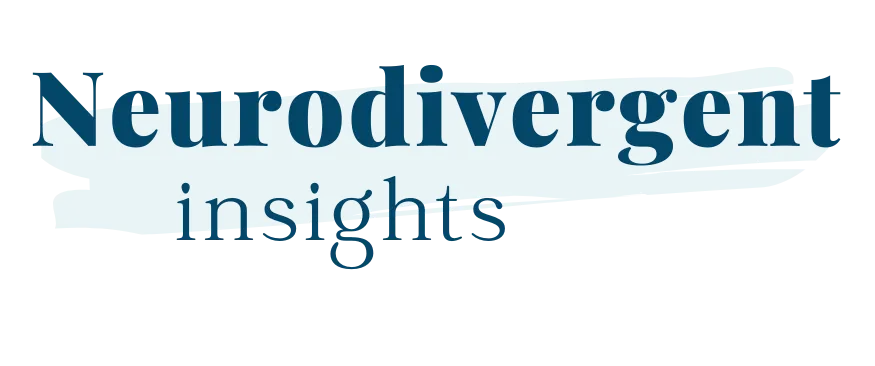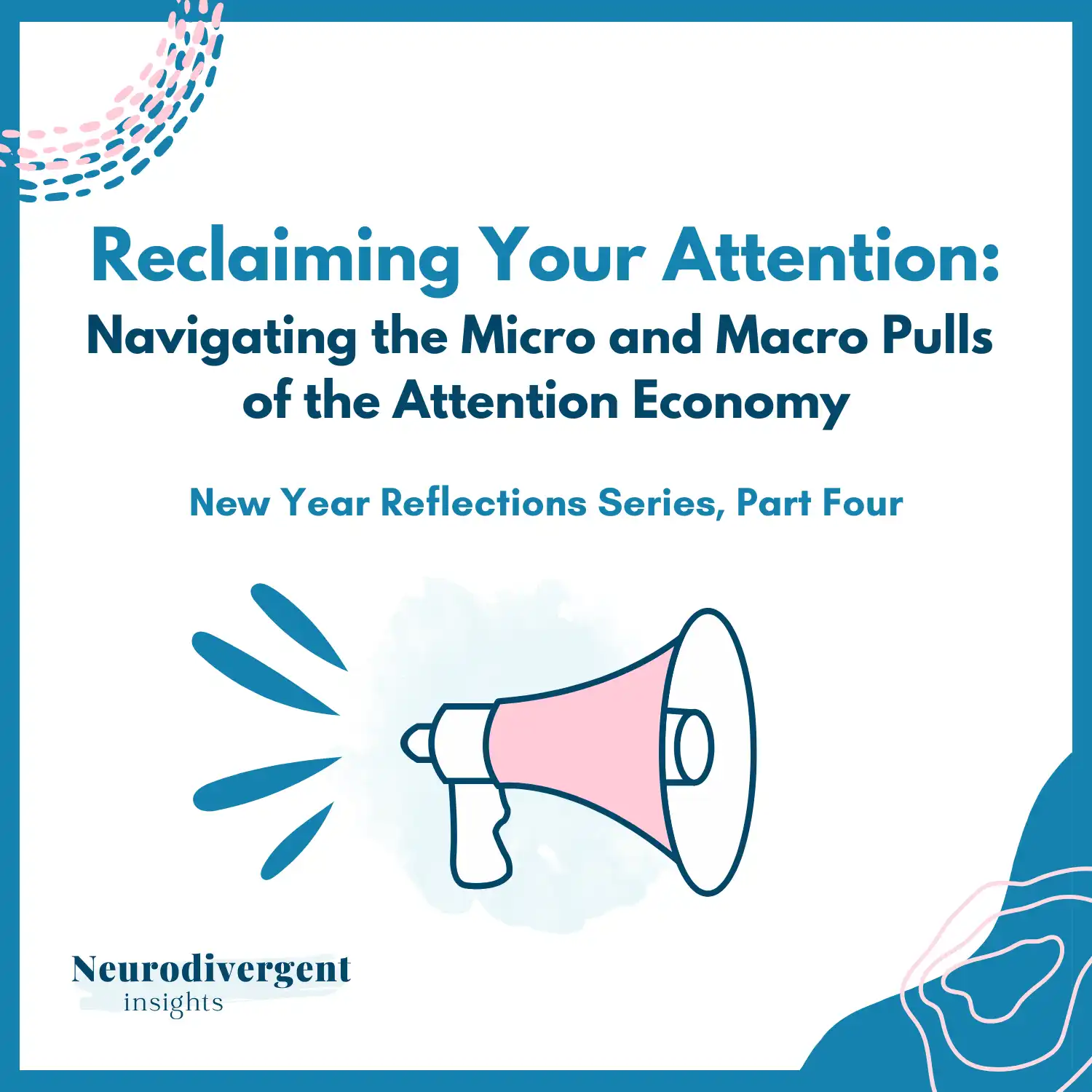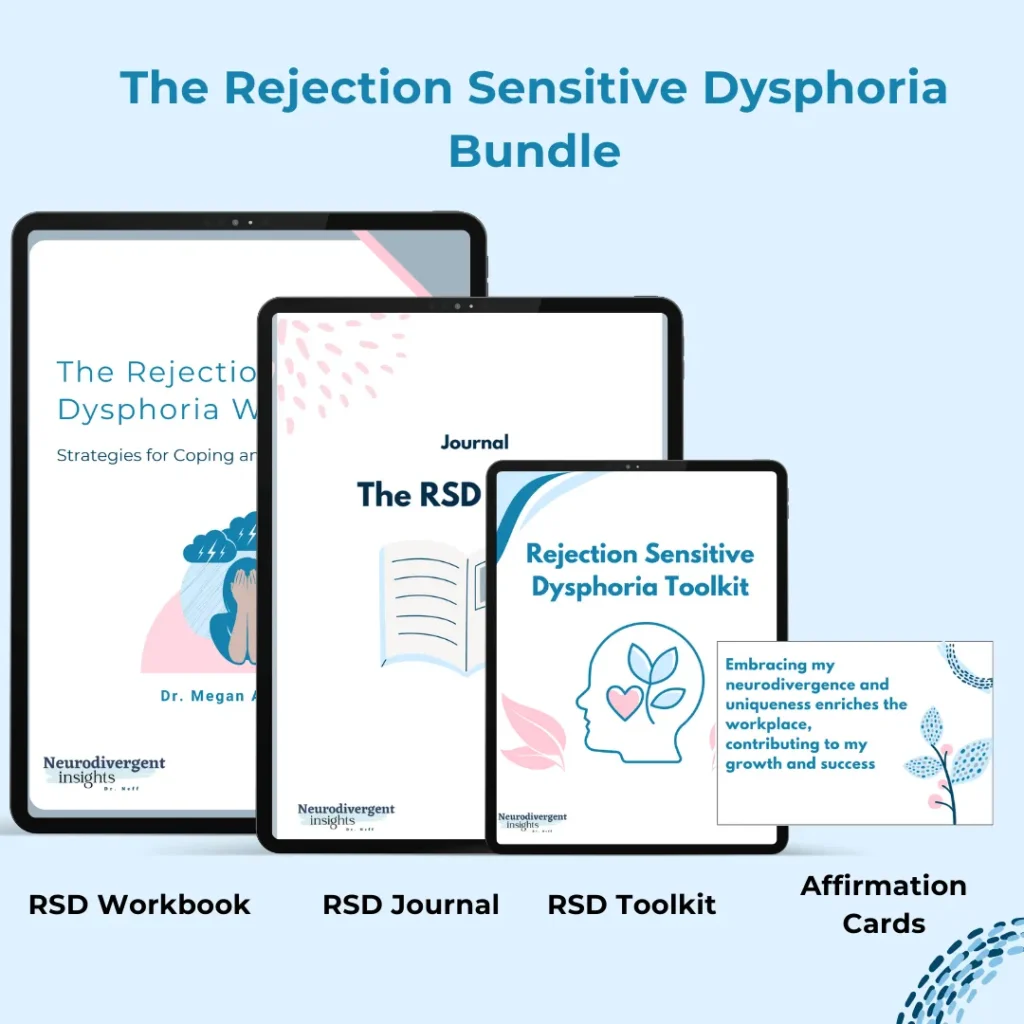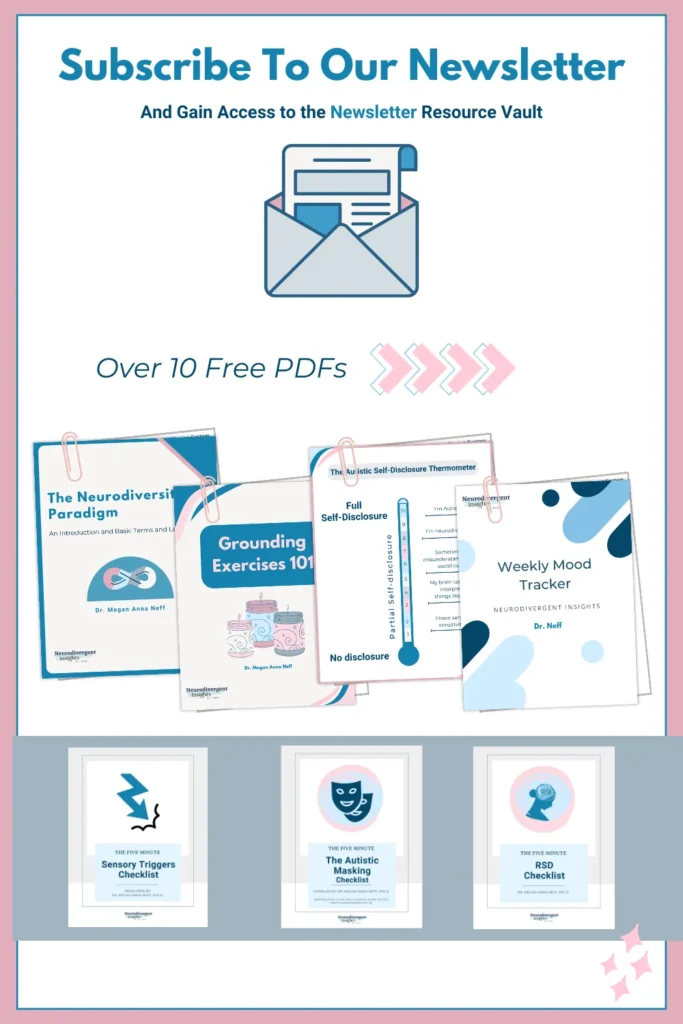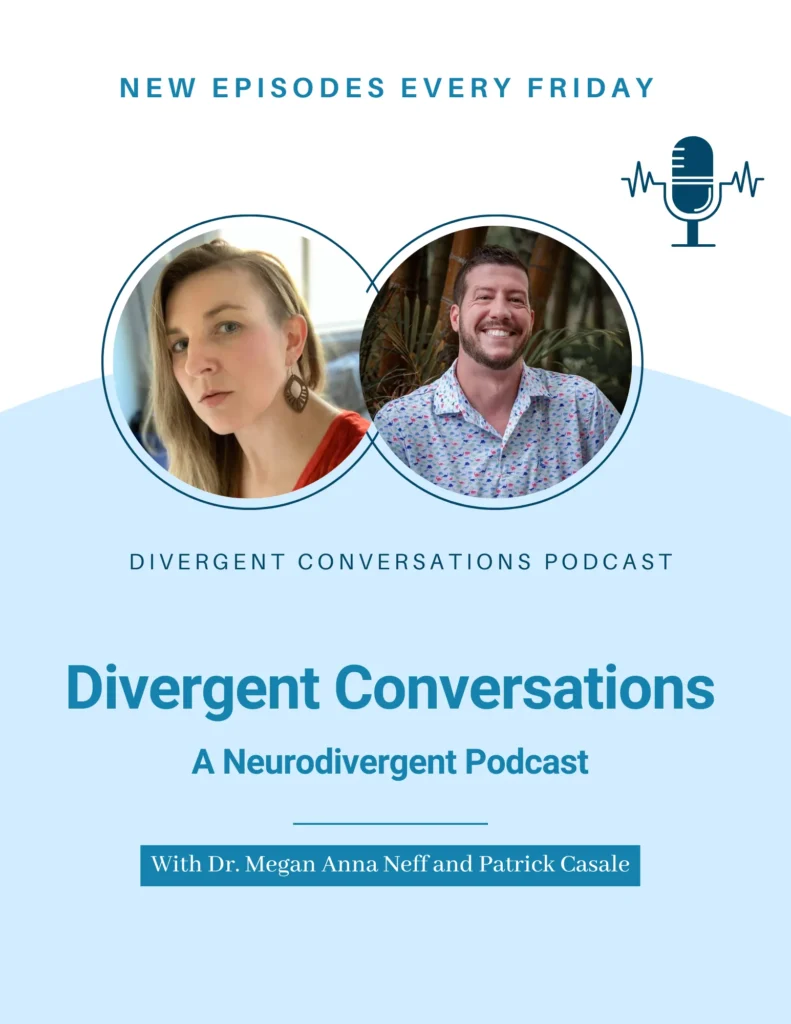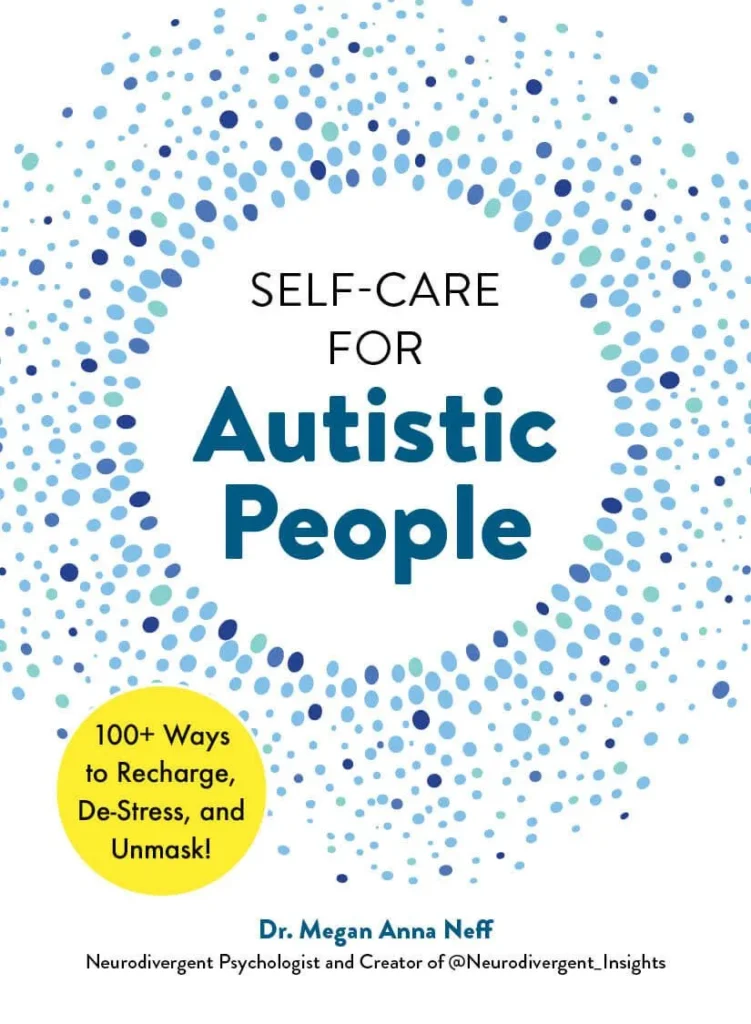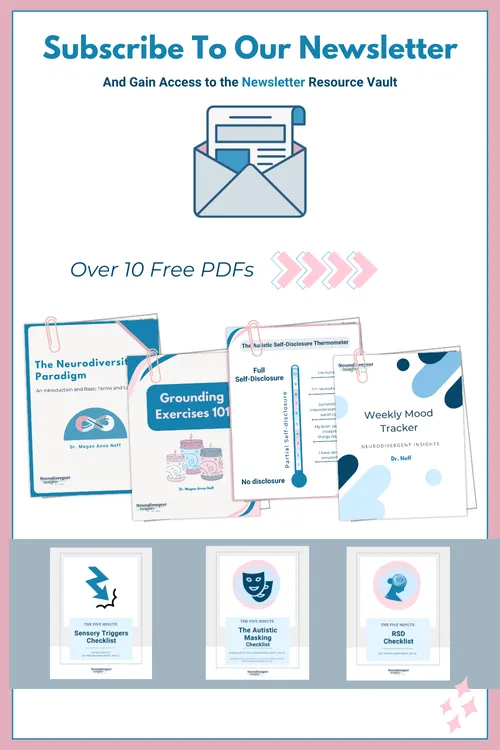
Disclosure: This post contains affiliate links. If you make a purchase through these links, I will earn a commission at no extra cost to you. As an Amazon Associate, I earn from qualifying purchases. Thank you for supporting Neurodivergent Insights!
Emotional Identification and Why It’s Important
During my first year of training to become a Psychologist, there was A LOT of focus on emotional identification. We were trained to offer restatements and reflections that would accurately and empathetically identify our client’s emotions. However, this part was really hard for me! I never understood why this was so hard for me until I learned I was an Autistic-ADHDer with alexithymia and am someone who struggles with emotional identification! It is more natural for me to lead with insights, analysis, observation, and education as a therapist. In fact, for much of my career, I’ve probably done too little with people’s emotions (at least in the traditional sense of identifying, labeling, and processing emotions).
Talking about emotions is not the most comfortable thing for me, and I’ve always treated emotions like “pesky little things” (I struggled to see the logic in them and therefore struggled to take them seriously). However, once I learned the science and neuroscience of emotions, and the benefits of emotional identification, I’ve begun to take this whole emotion thing a bit more seriously. Now encouraging emotional identification, emotional literacy, and teaching people how to increase their emotional literacy is something I am passionate about.
So here we are; we’re going to walk through some emotional awareness exercises and learn about emotional identification (something I never thought I’d be passionate about). But if you’re like me, learning why this is important will help motivate you to actually incorporate some of these exercises into your life. So before we get to the exercise that helps increase emotional awareness and literacy, let me first explain why emotional identification is important (if you are more evolved than me and already understand why it’s important and don’t need to justify its importance, feel free to skip down to the exercise portion of this article at this point).
Why is Emotional Identification Important?
Emotional identification simply means accurately identifying and labeling the emotion you’re experiencing in any given moment. It is an important part of emotional intelligence and can be helpful in improving your emotional awareness and regulation. It turns out that being able to identify your emotions is foundational for being able to calm down and tune down the intensity of your emotions. For this reason, emotional identification is often the first step in regulating our emotions. When we identify and label our emotions, we’re bringing awareness to what we’re feeling, which can help us better understand what we’re experiencing.
Research has shown that identifying emotions can improve emotional regulation, better decision-making, and a greater sense of well-being. There is one fascinating study about tarantulas that captures this well! The researchers found that the simple act of identifying and labeling our emotions (without trying to change them) can increase our tolerance for uncertainty and fear (you can read about the study here).
The Tarantula Study
Psychologists from the University of California conducted an experiment with 88 participants who feared spiders. They were asked to approach and touch a live tarantula in an open container. Participants were split into four groups:
✦ The first group was instructed to describe the emotions they were experiencing and to label their reactions to the tarantula, such as saying, “I am feeling anxious and frightened by this spider.”
✦ A second group was asked to reframe their thoughts in a more positive light, such as this spider can’t hurt me” (this is a classic CBT technique)
✦ In the third group, participants were told to say something irrelevant to the experience (a distraction technique)
✦ The fourth group was told to say nothing at all-they were simply exposed to the spider (an exposure technique).
The study found that simply acknowledging and labeling their emotions had the strongest impact on participants. Notice there was no attempt to change the emotion, thoughts, or experience. The participations were simply asked to identify and acknowledge their emotional experience. The act of labeling the emotion proved more helpful than CBT techniques aimed at changing the thought to be more positive. This makes intuitive sense to me and makes sense from a neuroscience perspective.
The Neuroscience of Emotional Identification
While the tarantula study didn’t elaborate on why their findings make sense, I’d like to try and explain why these findings make sense based on what we know about emotions, the brain, and neuroscience.
Broadly speaking, we experience three different kinds of emotions in our brains: reactive, routine, and reflective emotions. Reactive emotions are those primitive, hardwired, and innate emotions (such as fear and defensive rage) produced in response to a perceived threat. These emotions energize us for fight-and-flight and live in our so-called “reptilian brain” and limbic system.
Routine emotions such as happiness, sadness, surprise, and anger nourish our lives, lasting for a while and then fading. Humans, on average 30 or more different emotional states every day. These emotions don’t require thought-they occur as a matter of course. These originate in the sensory part of the brain. Personally, I don’t think I experience 30 of these a day, and my experience with alexithymia tells me that it is the routine emotions that are hardest for people with alexithymia to access.
And then, reflective emotions occur primarily in our prefrontal cortex and require conscious thought. Emotions such as anger, grief, and jealousy would be considered reflective emotions (Ruden, 2011).
Our reactive emotions are some of the hardest ones to cool off. Notice these are happening in the limbic and survival portions of the brain. Our prefrontal cortex is what houses our executive functioning and observing self. When this part of our brain is online, we’re more easily able to calm ourselves down. But the problem is—this is the precise part of the brain that tends to go offline during emotionally intense moments! And for ADHDers and Autistic people, some studies have shown we have reduced connectivity between the more emotional centers of our brains and our prefrontal cortex. This means we have to work harder to bring our prefrontal cortex back online during emotionally hot moments!
When we can take two seconds to pause and identify the emotion, we are bringing observing and reflective self to the forefront, which helps to bring our prefrontal cortex back online. This helps calm the whole system down. When we label our emotions, we recruit our prefrontal cortex to come help down-regulate the limbic system and so-called “reptilian brain.”
This is likely one reason we see increased rates of anxiety among people with alexithymia. Because they cannot label their emotions, they aren’t as easily able to recruit their prefrontal cortex to help out and self-soothe when their fear system gets activated! So for people who struggle with emotional regulation or alexithymia, emotional labeling can be particularly helpful in developing effective self-soothing and coping strategies.
The Benefits of Emotional Identification
In addition to being helpful for emotional regulation, there are several other benefits of increasing our emotional literacy and awareness, such as:
 ✦Improved self-awareness: By accurately identifying and labeling your emotions, we can become more self-aware and better understand our emotional experiences (our triggers, patterns and underlying needs and vulnerabilities).
✦Improved self-awareness: By accurately identifying and labeling your emotions, we can become more self-aware and better understand our emotional experiences (our triggers, patterns and underlying needs and vulnerabilities).
✦Improved communication: Being able to accurately identify and label our emotions can help us to communicate more effectively with others. It can also help us to better understand the emotions of others. This is particularly helpful for neurodivergent folx, who often experience additional communication barriers when interacting across-neurotype.
✦Improved Self-advocacy: It’s difficult to ask for what we need when we don’t know how we feel! Improving our emotional awareness can help us to more accurately ask for what we need and advocate for our needs.
✦Increased emotional intelligence: By improving our ability to accurately identify and label our emotions, we can improve our emotional intelligence and better understand and manage our emotional experiences. Additionally, increased emotional intelligence has been associated with several positive health and life outcomes.
✦Improved emotional regulation: As described above, accurately identifying and labeling our emotions can help us to better regulate our emotions and manage them in a healthier way.
✦Enhanced Connections: Being able to identify and label our emotions accurately can help us to navigate social situations and relationships more effectively while deepening our intimate connections with others.
Neurodivergence and Emotional Identification
Neurodivergent people (such as ADHDers, Autistic people, and people with c-PTSD)* often have more difficulty with emotional identification. This is related to several factors, such as interoception difficulties, increased rates of alexithymia, and differences in how we process and express emotions. When we struggle in this area, it can exacerbate some of our other struggles. For example:
✦ It can increase difficulties we experience around connecting with others and socializing
✦ It can make it more difficult to regulate our emotions
✦ It can intensify our anxiety (something many of us are prone to)
✦ It increases our difficulties and struggles associated with impulsivity
✦ It can increase our vulnerability to depression (something we’re already vulnerable to)
✦ It can make it harder to effectively communicate what we need and self-advocate
After learning about the connection between alexithymia, difficulty identifying emotions, and neurodivergent wellness, I have become quite passionate about educating neurodivergent people on how to increase their emotional awareness. It’s my personal opinion that this piece of support is a critical piece of the puzzle when it comes to supporting neurodivergent wellness and mental health.
Okay, have I sufficiently convinced you this is an important topic? Now that we’ve covered the “why,” let’s shift to the how. The rest of this article will focus on increasing emotional awareness and literacy by using several different emotional identification exercises.
Emotional Identification Activities
Several strategies help us to build emotional awareness. While many activities can help, I’ve narrowed it down to five activities to get you started. Remember that not all of these activities will resonate with you, but finding one or two that work for you is key.

Emotional Awareness Builders:
Visual Aids for Emotional Identification: Visual aids like the Feeling Wheel and Arousal-Valence Matrix are helpful tools for identifying your emotions. By using these tools, you can better understand the nuances of your emotions and how they are interconnected.
-
Reading Novels: Reading novels can help you increase your emotional literacy and awareness. Novels provide a window into characters’ emotional experiences, helping you understand the complexity of emotions and how they can affect behavior.
-
Using Music: Music has the power to invoke powerful emotions and can be an effective way of accessing and identifying your emotions. Pay attention to the emotions that music evokes in you and use them as a starting point for self-reflection.
-
Using Photos: Photos can be a powerful emotional prompt, especially for highly visual brains. By reflecting on the emotions evoked by the photos, you can gain a deeper understanding of your own emotions and experiences.
-
Journaling: Writing about your emotions and experiences in a journal can help increase your emotional awareness and literacy. This can help you to better understand and label your emotions, as well as track patterns and triggers.
By building one or two of these activities into your routine, you can improve your ability to identify and label your emotions and expand your emotional literacy. Next, we’ll discuss these five practices in more detail, providing tips and strategies to help you get started.
Using the Feelings Wheel
Visual aids like the Feeling Wheel and Arousal-Valence matrix can be beneficial for neurodivergent people as it provides visual support (versus depending solely on the verbal ability to identify and express emotions). (Note you can read more about how and why visual aids are helpful for emotional identification here).

The Feelings Wheel is a visual representation of different emotions. The Feeling Wheel is organized like a pie chart and is divided into several sections—the wheel organizes 72 feelings into six key areas: sad, angry, scared, happy, strong, and calm.
At the center of the wheel are six basic emotions: anger, fear, sadness, calm, strong, and happiness. Each of these emotions is then divided into more specific sub-emotions. So as you move toward the outer edges of the wheel, you’ll find more specific emotions. This structure helps you better differentiate and tease out what you are feeling with more specificity.
For example, under the emotion of joy, you might find sub-emotions like contentment, excitement, or gratitude. The wheel provides a visual representation of the range of emotions that we can experience and how they are related to one another. By using the wheel to identify and label emotions, we can become more aware of our own emotions and communicate our feelings with more accuracy to others.
How to Use the Feelings Wheel
Using the Feelings Wheel is a straightforward way to increase emotional literacy, boost emotional awareness, and gain a deeper understanding of your emotions.
To use the Feeling Wheel
✦ First, familiarize yourself with the Feelings Wheel: Take some time to familiarize yourself with the emotions on the wheel.
✦ Reflect on your emotions: As you go about your day, take a moment to pause and reflect on your emotions as you experience them.
✦ Use the Feelings Wheel to help you identify and label your emotions. You might find it helpful to point to the emotion on the wheel as you label it.
✦ Reflect on patterns and triggers: Take some time to reflect on your emotions and the patterns and triggers you notice. What events or situations tend to trigger certain emotions? What helps you to manage your emotions?
In addition to identifying the emotion you’re feeling, the Feelings Wheel can also help you identify the opposite emotion. The opposite emotion is located on the exact opposite side of the wheel and can give you information about what emotion might help you at any given moment. For example, if you’re feeling powerless, the opposite emotion might be feeling empowered and strong. In this way, the Feelings Wheel tells us what we’re feeling and what we might be longing for or needing at that moment.
The Feelings Wheel is a helpful tool for building emotional awareness, as it provides a visual representation of a wide range of emotions and helps us develop a nuanced understanding of our own emotional experiences. However, identifying and labeling emotions can be challenging, and if the feeling wheel overwhelms you I recommend you start with something more simple, such as the arousal-valence matrix of emotions.
Using the Arousal-Valence Matrix of Emotions
The Arousal-Valence Matrix is another visual aid that can help identify emotions. This tool plots emotions on a graph with arousal and valence axes. Arousal refers to the intensity of the emotion, while valence refers to whether the emotion is positive or negative.
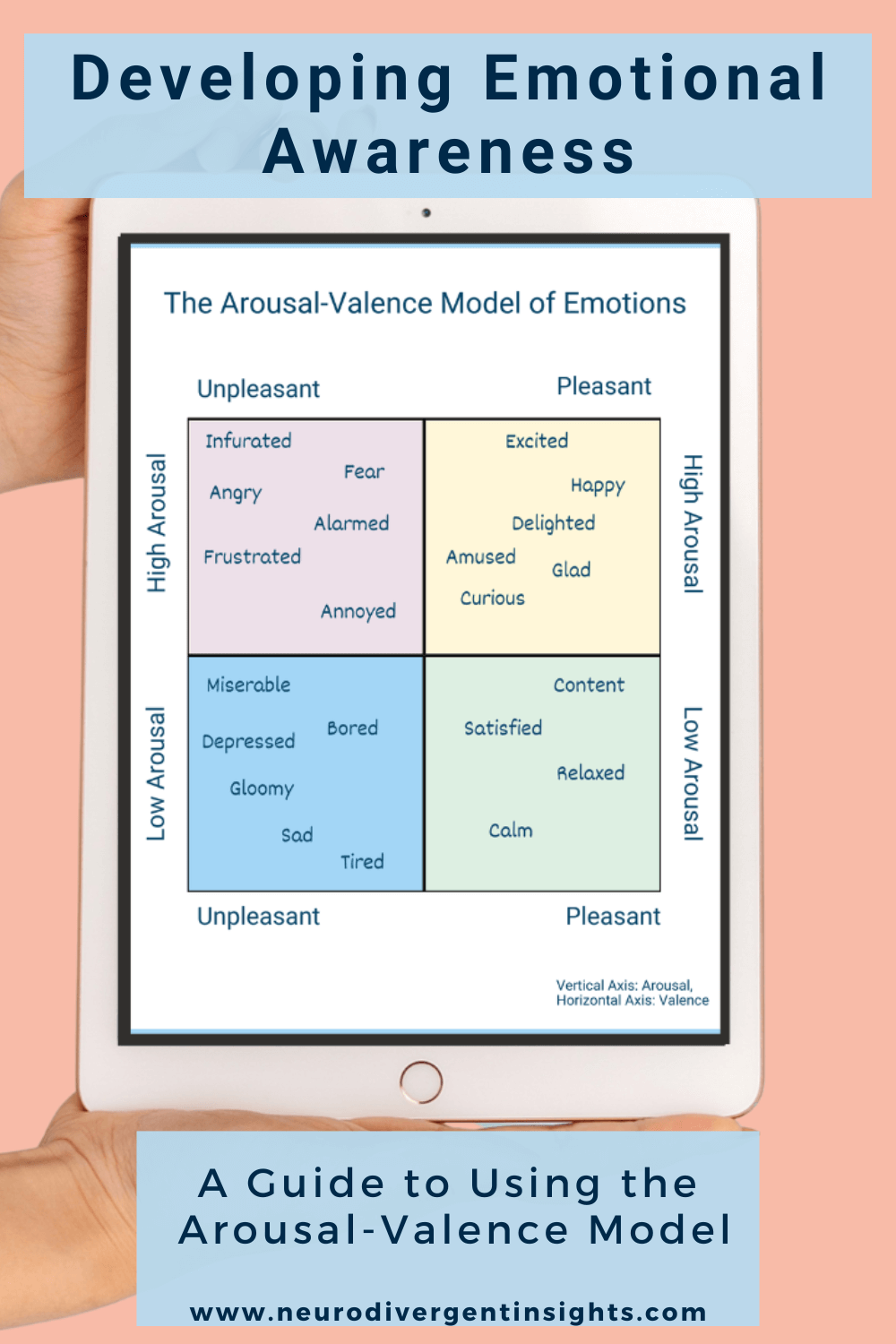
For example, happiness, excitement, fear, and anger would be plotted high on the arousal axis, while calm or sad emotions would be lower on the arousal axis. Meanwhile, positive emotions like joy or love would be on the right side of the valence axis, while negative emotions like fear or sadness would be on the left.
The matrix has four quadrants: high arousal/high valence (such as excitement or joy), high arousal/low valence (such as anger or fear), low arousal/high valence (such as contentment or relaxation), and low arousal/low valence (such as boredom or sadness).
The Arousal-Valence Matrix is helpful because it helps you identify your emotions and explains what might be causing them. For example, if you’re feeling anger, you might look at the high arousal/low valence quadrant and see that other emotions include fear and frustration. This might give you insight into what’s causing your anger and help you address it more effectively.
How to Use the Arousal-Valence Model
To use the Arousal-Valence Matrix, simply follow these steps:
✦ First, identify your energy level (high or low)
✦ Next, identify where you are on the pleasant to unpleasant spectrum.
✦ Once you have found your quadrant, see if you can identify the emotion more specifically (sad, bored, etc.). Keep in mind you may be feeling more than one emotion at once!
✦ After identifying the quadrant and emotion, use this as a guide for what to do next. The matrix can inform you about what you need at any given moment. For example, if you are feeling high arousal and negative valence, you might try deep breathing or other relaxation techniques intended to down-regulate and lower the intensity of the emotion. Alternatively, if you feel low arousal and low valence, you might engage in an activity that will increase your energy and positive mood, such as movement, gentle stretches or listening to upbeat music, or spending time in a special interest.
When it’s used in this way, the Arousal-Valence Matrix can both be a tool to help you better understand your emotions and can also inform you of what you need at any given moment. In that sense, it can help you develop effective strategies for emotional regulation. You can read more of a deep dive on how to use the arousal-valence model of emotions here.
Reading novels
Reading novels can be a valuable way to increase your emotional awareness. Novels are often written from the point of view of a character, providing an inside perspective into their emotional experiences. I have always found the novels of Dostoevsky to be particularly compelling, as he captures the complexity and nuance of the human experience with great depth. As you read more and encounter different perspectives and emotional experiences, you naturally become more attuned to the emotions and emotional words of the characters, which in turn, increases your emotional literacy.
To gain even more benefit from reading novels, you can pause and reflect on moments that invoke strong emotions in you. Consider how these emotions are connected to your own experiences and emotions. By doing so, you can use the emotions in the novel and your own emotional response as a springboard for deeper self-reflection.
Of course, if novels aren’t your thing, you can also achieve similar benefits from anime, comics, movies, and other story-based mediums. The key is to take the time to reflect on the emotions of the characters and your own emotional responses to them. By doing so, you’ll enhance your emotional literacy and become more skilled in identifying and managing your own emotions.
Listening to Music that Provokes Emotion
Listening to music can be a powerful tool for increasing emotional expression, particularly for those of us with alexithymia who may find it challenging to identify and feel our emotions. Music has the ability to tap into our emotions and evoke powerful feelings, which can be a valuable starting point for self-reflection and greater emotional awareness.To use music to increase your emotional awareness, try the following steps:
✦ Find music that evokes strong emotions: Look for music that elicits feelings of happiness, sadness, or anger.
✦ Pay attention to the emotions and bodily sensations it evokes in you: As you listen to the music, notice any changes in your mood or physical sensations that come with these emotions.
✦ Reflect on your emotions: Use the emotions evoked by the music as a starting point for self-reflection. Take a moment to think about the emotions you’re feeling and why. What can you learn about your own emotions from the music?
By listening to music that evokes strong emotions and paying attention to the bodily sensations and emotions it evokes, you can increase your emotional awareness and gain a deeper understanding of your own emotions. As an additional benefit, if you’re in therapy and struggling to talk with your therapist about your emotions, consider bringing in a song that captures how you’re feeling and listening to it together. This can help springboard emotional conversations in therapy and support you in working through difficult emotions.
Journaling & Writing
Writing in a journal or writing down your thoughts and feelings on paper is a powerful tool to increase your emotional awareness. By writing about your experiences and emotions, you can better understand and label your emotions and track patterns and triggers. Here are some steps to help you get started with journaling:
✦ Set aside some quiet time: Find a peaceful spot where you won’t be disturbed. It may help to schedule a specific time each day for writing.
✦ Write about your feelings: Take a few moments to reflect and write about your emotions. Use descriptive language to label the emotions you’re feeling and why.
✦ Write about your experiences: Jot down some notes about your recent experiences and the events and situations that triggered your emotions.
✦ Reflect on your writing: Take a look back at what you wrote and see if you can identify any patterns or triggers. What activates your emotions? What helps you feel better when upset?

If journaling feels overwhelming, consider trying bullet journaling, where you can simply jot down three emotions you noticed during the day. If journaling feels too open-ended, you might try working through a journal that provides prompts and guidance. Here are a few of my favorite guided journals:
✦ Wreck This Journal by Keri Smith: This journal includes collage and journaling, which was a lifeline for me as a depressed, undiagnosed ADHD-Autistic teenage girl!
✦ The Anxiety Check-In journal: This journal provides prompts and guidance for people who like structure in their journaling process.
By writing in a journal, you can increase your emotional awareness, better understand and manage your emotions, and identify patterns and triggers.
Using Photos
Many neurodivergent people are more visually oriented, so photos and visuals can be a powerful tool for increasing emotional awareness. Similar to music, photos, and visuals can act as emotional prompts and evoke emotions that may be difficult to access through verbal language alone. Using photos to increase your emotional awareness can be a fun and engaging way to explore your emotions and better understand and identify your feelings.
If you’re not into drawing, no worries! Here’s a simple exercise you can do with photos:
✦ First, gather some photos: Look for photos that evoke strong emotions in you, whether they be happy, sad, or something else. These can be physical photos you own, or you can search for images online using free stock photo websites like Unsplash. If you’re feeling a particular emotion like sadness or happiness, try searching for related photos. If not, simply choose photos that you’re drawn to.
✦ Pay attention: Take a moment to look at the photos you’ve selected and notice what emotions they evoke in you.
✦ Reflect on your emotions: Consider the emotions you’re feeling and why you’re feeling them. This exercise requires the use of your prefrontal cortex and reflective emotions, which can be a valuable tool for increasing emotional awareness.
✦ Use the emotions evoked by the photos as a starting point for self-reflection: Consider using the emotions evoked by the photos as a starting point for self-reflection. What can you learn about your own emotions from the photos?
By using photos to explore your emotions and paying attention to the emotions they evoke, you can increase your emotional awareness and strengthen your emotional literacy. This exercise may feel strange at first, so be patient with yourself as you work on it. With practice, you may find that it becomes a valuable tool for increasing emotional awareness and understanding your emotions on a deeper level.
Bonus: Using Therapy-Specific Tools
Using therapy-specific tools can be a helpful way to increase your emotional awareness. These tools are designed to help you better understand and identify your emotions and can be a useful addition to your self-care routine. To use therapy-specific tools to increase your emotional awareness, try the following steps:
-
Choose a tool: There are many therapy-specific tools available, such as emotion wheels, mood journals, mindfulness cards, and emotion cards. Choose a tool that resonates with you and that you feel comfortable using.
-
Use the tool: Follow the instructions for using the tool and take some time to explore your emotions.
-
Reflect on your emotions: Take a moment to think about the emotions you’re feeling and why.
-
Use the tool as a starting point for self-reflection: Consider using the tool as a starting point for self-reflection. What can you learn about your own emotions from using the tool?
By using therapy-specific tools to explore your emotions and paying attention to the emotions they evoke in you, you can increase your emotional awareness and better understand your own emotions. It might take a little time to get used to using these tools, so be patient and compassionate with yourself as you work on it.
Summary: Emotional Identification
Emotional identification essentially involves the ability to recognize and label your emotions as you experience them. When we’re able to do this, we’re more easily able to regulate our difficult emotions and communicate our needs. Emotional identification plays an important part in emotional intelligence and emotional literacy. These skills can be more difficult for neurodivergent people, so supporting emotional identification can be an important part of our support.
You can use several strategies and practices to improve your emotional identification, such as journaling and writing, visual aids like the Feelings Wheel and arousal-valence matrix, and listening to music that provokes emotion. Practicing these activities regularly can improve your emotional awareness and better understand and manage your emotions. Some of these practices may initially feel awkward, and that’s okay! Do your best to be patient and gentle with yourself as you develop these skills, as it may take some time to become more attuned to your emotions. For more of a deep dive into emotions (what they are and how to work with them), you can check out my workbook on emotions.
This post was proofread by Grammarly, my go-to for proofreading and catching all the details I naturally miss! Grammarly is entirely free to use. Click here to give it a try.
Citations
Kircanski, K., Lieberman, M. D., & Craske, M. G. (2012). Feelings Into Words: Contributions of Language to Exposure Therapy. Psychological Science, 23(10), 1086–1091. https://doi.org/10.1177/0956797612443830
Ruden, R. A. (2011). When the past is always present: Emotional traumatization, causes, and cures. Routledge.
